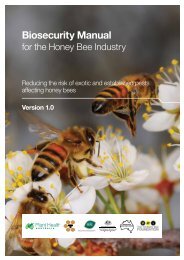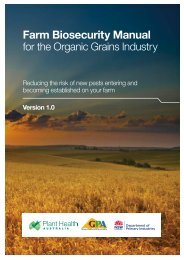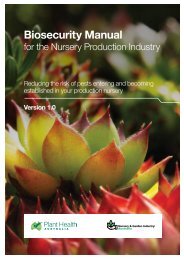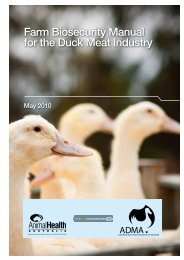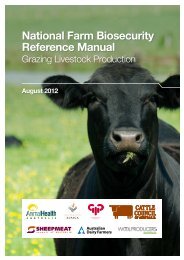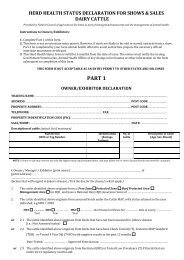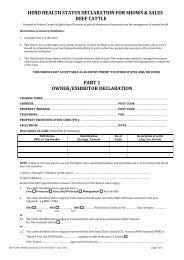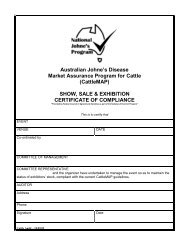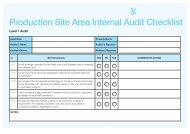Orchard Biosecurity Manual for the Mango Industry - Farm Biosecurity
Orchard Biosecurity Manual for the Mango Industry - Farm Biosecurity
Orchard Biosecurity Manual for the Mango Industry - Farm Biosecurity
You also want an ePaper? Increase the reach of your titles
YUMPU automatically turns print PDFs into web optimized ePapers that Google loves.
6<br />
Pests<br />
High priority exotic pest threats of <strong>the</strong> mango industry<br />
The following are some key exotic pest threats <strong>for</strong> <strong>the</strong> Australian mango industry as<br />
identified through <strong>the</strong> development of <strong>the</strong> <strong>Mango</strong> <strong>Industry</strong> <strong>Biosecurity</strong> Plan (IBP). Any of<br />
<strong>the</strong>se pests would have serious consequences should <strong>the</strong>y enter and become established<br />
in Australia. For a complete list of identified exotic pest threats <strong>for</strong> <strong>the</strong> mango industry,<br />
refer to <strong>the</strong> <strong>Mango</strong> IBP, available from www.phau.com.au/biosecurity/mango<br />
Oriental fruit fly complex (Bactrocera spp.)<br />
OVERALL RISK – HIGH<br />
• Can cause up to 100% fruit loss<br />
• Adults 6-8 mm long with a narrow brown band along <strong>the</strong> edge of<br />
<strong>the</strong> wings<br />
• Abdomen has a distinctive black T-shaped mark, which is similar to a<br />
number of o<strong>the</strong>r endemic species<br />
• Larval feeding can result in rotting of fruit and may cause fruit to drop<br />
• Long range dispersal through movement of larvae-infested fruit<br />
<strong>Mango</strong> pulp weevil (Sternochetus frigidus)<br />
OVERALL RISK – HIGH<br />
• Causes high economic losses to mango industries in Asia<br />
• Adults are 6-9 mm long, stout, and dark brown with paler patches<br />
• Unlike <strong>the</strong> <strong>Mango</strong> seed weevil, larvae only feed on <strong>the</strong> pulp<br />
• Circular exit holes appear in <strong>the</strong> fruit when adult weevils emerge<br />
• Long range dispersal through movement of infested fruit<br />
<strong>Mango</strong> mal<strong>for</strong>mation disease (Fusarium spp.)<br />
OVERALL RISK – HIGH<br />
• Found in India, Egypt, Africa, Central America, Brazil, Mexico,<br />
Malaysia, Pakistan<br />
• Most important floral disease of mangoes worldwide<br />
• Causes mal<strong>for</strong>med shoots and inflorescences<br />
• Panicles are thickened with large flowers and inflorescences appear<br />
crowded<br />
• Long range dispersal via infected plant material and pruning equipment<br />
<strong>Mango</strong> gall midges (Procontarinia spp.)<br />
OVERALL RISK – HIGH<br />
• Found in India, Africa, Malaysia<br />
• Eggs laid on leaves cause small red spots<br />
• Wart-like galls <strong>for</strong>m quickly and extend up to 3-4 mm in diameter<br />
• Heavily galled leaves can curl up and drop off prematurely, causing<br />
dieback of whole branches in susceptible cultivars<br />
• Long range dispersal through movement of infested plant material<br />
DEEDI Barry Conde, DoR, NT<br />
Dr Mohd. Shamsudin Osman, Scott Bauer<br />
MARDI, Malaysia



